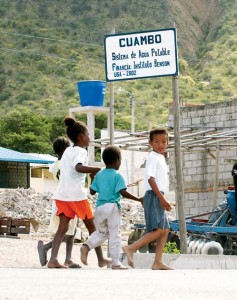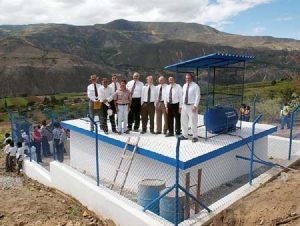
The Benson Institute and the Bumstead families combined with villagers in Cuambo, Ecuador, to build a culinary water system.
By Grant Madsen, ‘98
POINTING to the pillow on the bed of his mud-walled home, Ecuadorian farmer Agnelio Lara shares the secret behind the construction of Cuambo’s culinary water system. Just weeks before, he had the idea to rope pillows to his back, making the sacks of unmixed concrete more comfortable to lug up six miles of mountain to a freshwater spring.
“It was all easy going after that,” says Lara, with a wink.
Under the direction of BYU‘s Ezra Taft Benson Agriculture and Food Institute, Lara and other members of the Afro-Ecuadorian village of Cuambo spent five months manually digging 1-meter-deep trenches for a pipeline route. In 100-degree heat, they carried enough sand, gravel, concrete forms, and cement up the pipeline course to create a culinary water system.
Two months later, Lara and his companions sat unassumingly in the back of Cuambo’s elementary school, where Allen C. Christensen, ’57, director of the Benson Institute, as well as community, state, and national leaders, dedicated the result of the village’s efforts.
“The inauguration festivities recognized that the dream of quality, culinary water has become a reality due to the combined efforts of many,” says Christensen. “The new system will benefit the villagers of Cuambo for years to come.”
Before the system’s construction, villagers drank contaminated irrigation runoff, resulting in health problems and a high infant-mortality rate. Now, the village, two-and-a-half hours north of Quito, provides potable water to each of its 75 homes, with sufficient reserve capacity to accommodate double that number in the future.
“It’s heaven for us to have clean water conveniently come to our homes,” says Yolanda Maria de Suarez, longtime resident and mother of 10. “Little by little, Cuambo is changing for the better.”
The water project is just one aspect of the institute’s integrated program of teaching methods to increase crop production, improve health, and enhance nutrition. The institute also works in Bolivia, Ghana, Guatemala, Mexico, and Morocco. The program is adapted to the needs and resources of each community—in Cuambo, for instance, participating families are taught to raise guinea pigs, a traditional source of protein.
Current projects in Ecuador are made possible through the Michael A., ’78, and Diane Bumstead and Steven G., ’71, and Jacque Bean, ’69, Bumstead families of Seattle. Two years ago, the Bumsteads visited Cuambo and learned of its need for a culinary water system. Working closely with the Benson Institute’s Richard L. Brimhall, ’68, the family donated funds for the system’s construction with the provision that residents would provide necessary labor and undergo training to maintain and manage it.
A water-use committee headed by villager Pedro Arnulfo Suarez will maintain the system with funds generated by a nominal-use fee.

Before the new water system dedication on July 10, Benson Institute administrators and donors inspect the holding tank.
“The Benson Institute and the Bumsteads have graciously provided us with the ability to access the fresh water we desperately needed,” says Suarez. “We feel blessed as a village to have worked shoulder to shoulder with them in this accomplishment.”
“The beauty of this program is the way it teaches people to become self-sufficient,” says Raquel Tustón, Benson Institute project administrator in Ecuador, who was an intern in a similar institute program as a senior at Ecuador’s University of Chimborazo. “To reap long-term benefits of the new water system, the villagers of Cuambo will employ skills they’ve learned in the program.”
One such villager is Rubi Chala, president of Cuambo’s Organization of Women, who encouraged others to adopt Benson Institute techniques in 2000.
“I tell others to participate because I’ve noticed better health among my family,” says Chala, a mother of eight. “Thanks to the Benson Institute, there’s less sickness in the village.”









